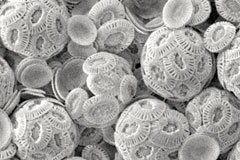Posted on The Daily Nexus: 17 Apr 2013 — By Haley Kulik

E. huxleyi are ocean-regulating shell producers that create oxygen as they process carbon by photosynthesis.
Researchers in the Department of Ecology, Evolution and Marine Biology have discovered a line of marine organisms that actually increase their calcification, or creation of new shells, in ocean waters with dropping pH levels, despite prior evidence indicating that ocean acidification leads to decreased calcification and the dissolving of marine life shells.
UCSB professor Debora Iglesias-Rodriguez and postdoctoral researcher Bethan Jones — who is now working with Rutgers University — led a study which they found the unicellular marine coccolithophore Emiliania huxleyi still managed to develop shells when exposed to waters with high carbon dioxide levels. Such evidence runs contrary to previous scientific thought which theorized that water affected by ocean acidification lead to the dissolving of shells and decreased calcification.
The study, which was funded by the European Project on Ocean Acidification, was published in the newest issue of the scientific journal PloS ONE.
Calcifiers, which produce shells or skeletons made of calcium carbonate, must live in a certain oceanic environment in order to have healthy shells and skeletons, and the rise in carbon dioxide can negatively affect such an environment.
The new study challenges this theory of ocean acidification harming calcification in marine life, according to Iglesias-Rodriguez.
“With ocean acidification, these carbonate ions decrease in concentration as carbon dioxide levels go up, and that is why scientists are concerned about whether or to what extent these organisms will be able to continue making their shells,” Iglesias-Rodriguez said in an e-mail. “However, we know now that there is huge diversity in the response of marine species. Although most organisms respond to ocean acidification by decreasing their calcification, some are not affected and some even increase shell-making.”
The study simulated present-day carbon dioxide conditions and found that E. huxleyi is resilient in conditions of ocean acidification, however the plant does not go completely unharmed under these high carbon dioxide conditions, Iglesias-Rodriguez said.
“We find that cells grown under high carbon dioxide grew more slowly and resulted in decreased expression of only four proteins that are probably associated with growth,” Iglesias-Rodriguez said in an e-mail. “Proteins involved in a lot of metabolic activities remain unaffected so they seem to be able to tolerate high carbon dioxide. Calcification was unaffected but there may be an ecological disadvantage if this ecotype grows more slowly and is outnumbered by another species using the same resources.”
More information: Bethan M. Jones, M. Debora Iglesias-Rodriguez, Paul J. Skipp, Richard J. Edwards, Mervyn J. Greaves, Jeremy R. Young, Henry Elderfield, C. David O’Connor (2013) Responses of the Emiliania huxleyi proteome to ocean acidification. PLoS ONE, dx.plos.org/10.1371/journal.pone.0061868